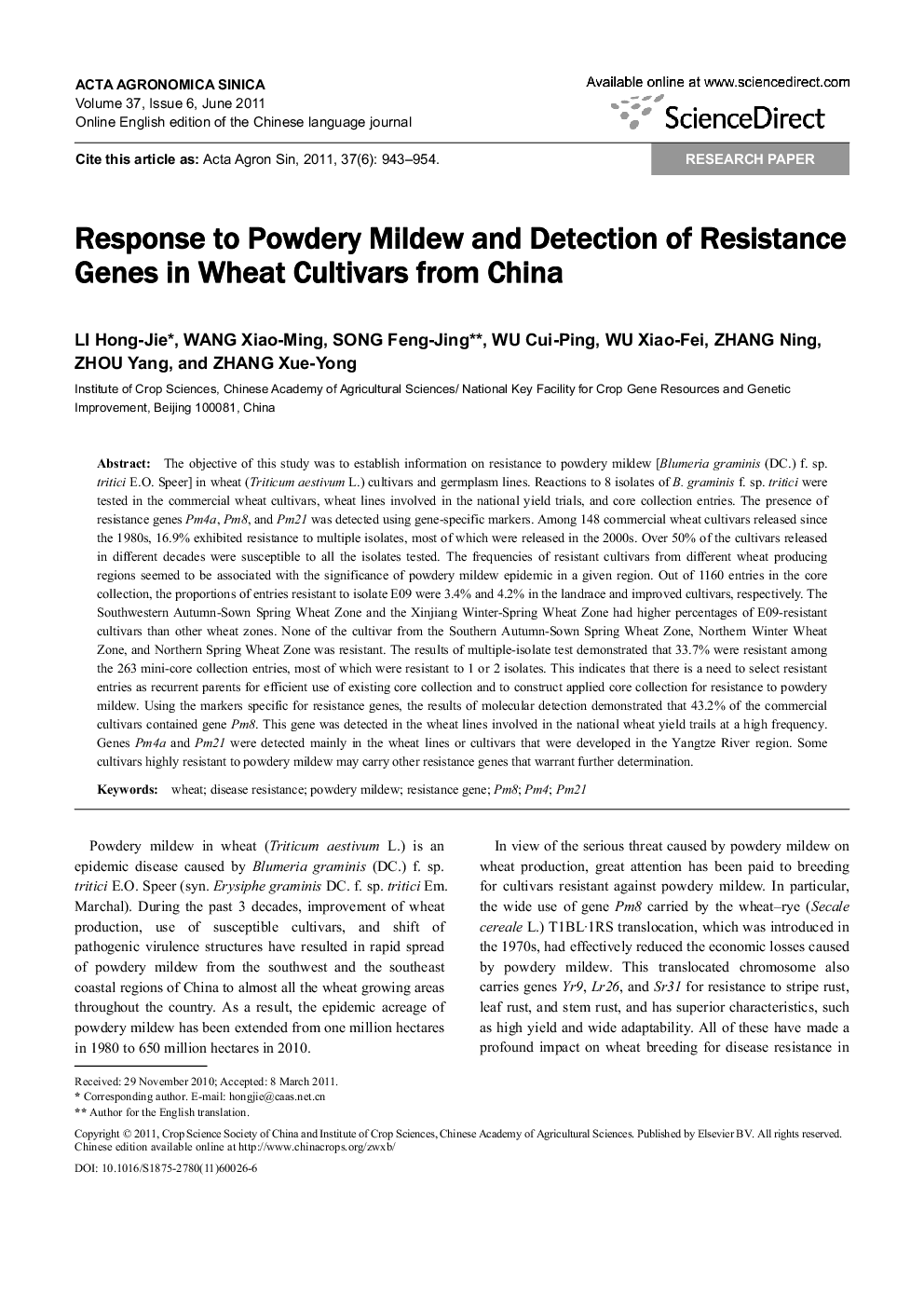| Article ID | Journal | Published Year | Pages | File Type |
|---|---|---|---|---|
| 4503218 | Acta Agronomica Sinica | 2011 | 12 Pages |
The objective of this study was to establish information on resistance to powdery mildew [Blumeria graminis (DC.) f. sp. tritici E.O. Speer] in wheat (Triticum aestivum L.) cultivars and germplasm lines. Reactions to 8 isolates of B. graminis f. sp. tritici were tested in the commercial wheat cultivars, wheat lines involved in the national yield trials, and core collection entries. The presence of resistance genes Pm4a, Pm8, and Pm21 was detected using gene-specific markers. Among 148 commercial wheat cultivars released since the 1980s, 16.9% exhibited resistance to multiple isolates, most of which were released in the 2000s. Over 50% of the cultivars released in different decades were susceptible to all the isolates tested. The frequencies of resistant cultivars from different wheat producing regions seemed to be associated with the significance of powdery mildew epidemic in a given region. Out of 1160 entries in the core collection, the proportions of entries resistant to isolate E09 were 3.4% and 4.2% in the landrace and improved cultivars, respectively. The Southwestern Autumn-Sown Spring Wheat Zone and the Xinjiang Winter-Spring Wheat Zone had higher percentages of E09-resistant cultivars than other wheat zones. None of the cultivar from the Southern Autumn-Sown Spring Wheat Zone, Northern Winter Wheat Zone, and Northern Spring Wheat Zone was resistant. The results of multiple-isolate test demonstrated that 33.7% were resistant among the 263 mini-core collection entries, most of which were resistant to 1 or 2 isolates. This indicates that there is a need to select resistant entries as recurrent parents for efficient use of existing core collection and to construct applied core collection for resistance to powdery mildew. Using the markers specific for resistance genes, the results of molecular detection demonstrated that 43.2% of the commercial cultivars contained gene Pm8. This gene was detected in the wheat lines involved in the national wheat yield trails at a high frequency. Genes Pm4a and Pm21 were detected mainly in the wheat lines or cultivars that were developed in the Yangtze River region. Some cultivars highly resistant to powdery mildew may carry other resistance genes that warrant further determination.
摘要利用来自不同生态区的8个白粉菌菌株对20世纪80年代以来国家审定(认定)品种、近期参加国家区域试验的品系和核心种质等小麦材料进行抗病性评价, 同时利用与Pm4a、Pm8和Pm21基因连锁的分子标记检测了相关抗病基因的存在。在148个国家审定品种中有16.9%的品种能够抗多个菌株, 其中大多是近10年选育的品种。不同年代审定的品种中感病品种的频率均超过50%。各个小麦生产区抗病品种的频率高低与该地区白粉病的严重性和育种的关注程度有一定关系。在1 160份小麦核心种质中抗E09菌株的地方品种和育成品种的比例只有3.4%和4.2%。西南冬麦区和新疆冬麦区入选的品种抗病频率较高, 华南冬麦区、东北春麦区和北方春麦区没有发现抗E09菌株的品种。多菌株鉴定结果表明, 263份微核心种质中33.7%的品种表现抗病性, 其中大多数品种能够抗12个菌株, 因此在核心种质的利用中应注意选用抗性强的品种作为轮回亲本, 同时有必要构建抗白粉病的应用核心种质, 以提高核心种质的利用效果。根据抗病基因分子标记检测结果, 我国小麦品种有43.2%含有Pm8基因, 该基因在区域试验参试品种中的频率也很高, 特别是在黄淮麦区培育的品种中频率仍高达50% Pm4a和Pm21基因主要出现在长江流域培育的品种中。有些抗性突出的品种可能含有其他抗病基因。
